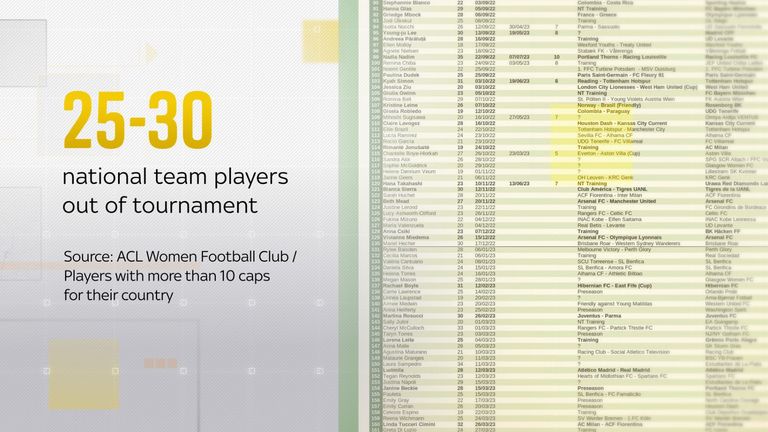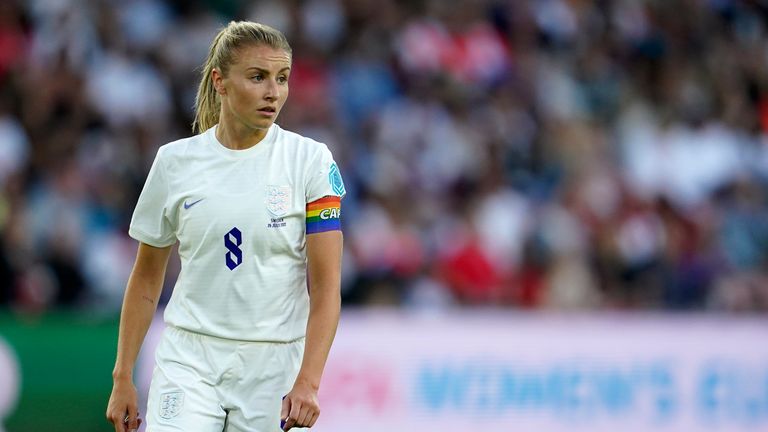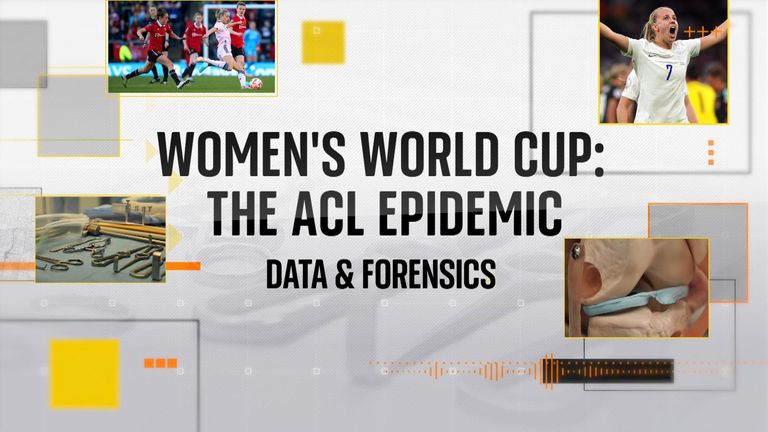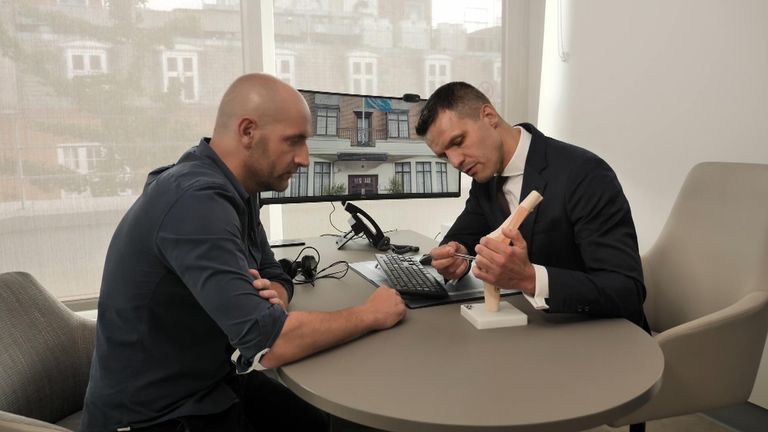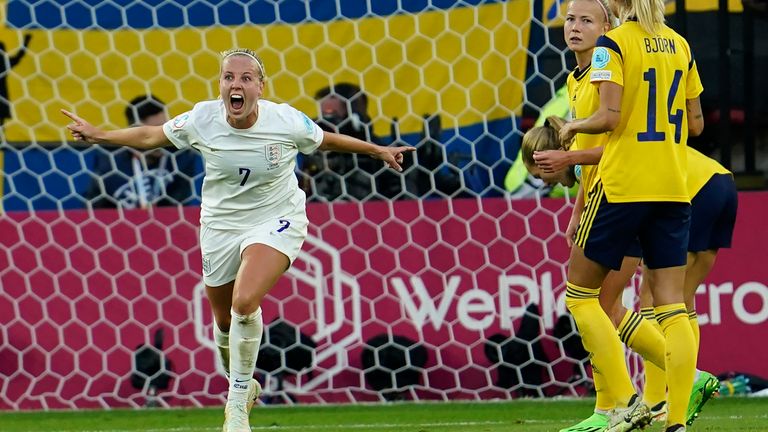Keyhole surgery is perhaps a misleading term: despite the technology, expertise and extreme finesse involved, it’s also hugely physical.
Sky News watches as surgeon Luke Jones performs an anterior cruciate ligament reconstruction in an operating theatre in King Edward VII’s hospital in central London.
Mr Jones (male surgeons are referred to as Mr rather than Dr) doesn’t just remove a hamstring: he pulls it out with force.
Drills bore through bone. Flesh smokes as it is cauterised. There’s a fair amount of hammering: “Mallet, please,” Mr Jones asks his assistant.
The ACL is a small band of tissue running through the middle of the knee that keeps it stable.
But watching the operation, it’s easy to understand why tearing it is so devastating. Even though the patient will only have three tiny scars, their knee has taken a pummelling.
“There’s 90 minutes in theatre with me,” Mr Jones tells Sky News, adding: “And then there is one year of rehabilitation with your physiotherapist afterwards.”
That’s why ACL injuries are so feared, especially by one type of athlete: female footballers.
‘Way too many’ women’s players with ACL injuries
Between 25 and 30 players – enough for an entire extra squad – will miss the upcoming World Cup because of ACL injuries. England stars Beth Mead and Leah Williamson have been ruled out. Data from ACL Women Football Club suggests 195 elite players have suffered the injury in the last year.
It has been described as an “epidemic”. And it is an epidemic that affects women far more than men: they are 2.5 to 3.5 times more likely to rupture an ACL than a male athlete. And we don’t really know why. Even as the women’s game has boomed, research has lagged behind.
One player who is going to the World Cup is England defender Jess Carter. Speaking before departure at St George’s Park, England’s national football centre, she tells Sky News: “There’s been way too many women’s players who have had ACL injuries and not enough research that’s been done about it.
“Why are there so many injuries? How can we prevent it? Why are they happening? A question I sometimes ask is: if this was happening to high profile men’s players, would more work be going in to try and improve things?”
Nature versus nurture
The problem is that there isn’t just one answer.
“I’ve made a list the other day, and I think there are 30 reasons that have been discussed in the literature that I could find,” says Kat Okholm Kryger, a sports rehabilitation researcher at St Mary’s University Twickenham and a medical researcher for FIFA.
“And I think we can split it into two main categories. And I like to call them nature and nurture.
“So the nature is like the biology: the genes, the way the body is shaped and muscle mass, etc… But also the nurture of the environment that the women are in. So the way that young female players are managed compared to male players, the facilities, the professionalism around the sport, the quality of the staff that they have available.”
I ask whether research into injuries in the women’s game has received as much attention as men’s.
“Attention? No. But generally that’s across all research in football and in sports medicine. The male has been the norm,” she adds.
Research will end up benefiting the men’s game too
Take one issue from the realm of ‘nurture’ that Kat is studying: football boots. The male foot was the norm. It’s only in recent years that boots designed specifically for women have become available. And even then we don’t understand the differences properly, which is why Kat has done 3D scans of hundreds of feet, to map them.
That research will end up benefiting the men’s game too because Kat is also charting the differences between ethnicities. Because the default foot isn’t just a man’s, it’s a white man’s.
The male is also the norm when it comes to other environmental factors, like booking a pitch.
On a Thursday evening in Kent, the Gravesham Girls and Women’s Football Club, founded in 1999, is training ahead of the start of the season. About 20 players, kitted out in yellow, are doing shooting drills and balls are flying. A Sky News camera operator cops one in the belly but bravely continues.
Click to subscribe to the Sky News Daily wherever you get your podcasts
Toni Allen and Keylie Oliver have both ruptured their ACL in the past. “I just screamed – everyone thought it was a fox,” Allen says. Both were out for a year.
“It’s quite daunting, and especially when you realise it’s not just football that it can impact, Oliver says.
“We have lives outside of football and it impacts that as well… At grass roots, the ladies always have a two o’clock kick-off. And that is because in our world, men’s football takes priority over women. We always have to play after – so the pitch is always ruined.”
The importance of the factors can change
Another difficulty is not just that there are lots of factors involved, it’s that the importance of the factors can change.
Professor Kirsty Elliott-Sale is professor of female Endocrinology and Exercise Physiology at the Manchester Met Institute of Sport.
She works closely with clubs, including Arsenal, to study how the menstrual cycle, or taking the Pill, can influence injuries. Research seems to suggest that some hormones can make ligaments looser, increasing the risk of rupture.
So over the course of the season Prof Elliott-Sale measures the laxity of players’ knees, charting that against their hormones, and cross referencing it with other factors like match congestion.
“It’s definitely a jigsaw,” she says. “And it’s about sort of putting all the pieces together.
“But once we have all the pieces, we don’t necessarily know which factor is going to play a bigger role on any given day. So it’s not like all of the pieces are the same size. Some days, a particular factor that might influence this type of injury might be amplified, whereas on another day, it might be turned down.”
Biology remains a large part of the answer
But even then the difference between female and male body types – which in the past led to some dismissing women as too “fragile” to play traditionally male sports – may not be as much of a factor as previously thought.
Because in some sports, the ACL injury discrepancy disappears.
“If you compare sports, where males and females start at the same age, have the same training intensity throughout their sporting life, and perform the same movements during that sport, then actually, the rupture rates equalise,” Mr Jones, the surgeon, says.
“And a very good example for that is elite dancers. So elite dance athletes, where the males and females start their training at the same age, they perform the same pivoting, jumping, twisting movements, and they have the same intensity of training and the same conditions. If you compare their rupture rates, they’re actually equalised.”
“And what that suggests is the impact of your training and your conditioning is really essential and avoiding this injury.”
Every expert I spoke to stressed the role of strength and conditioning in preventing injury. Here, nurture influences nature.
“We have that attitude of, you know, women do yoga, and pilates and men lift heavy things in the gym,” Ms Kryger says.
“But the reality is everyone needs to lift heavy things occasionally to prevent injuries and have a healthy body.”
Read more:
Women’s World Cup warm-up match abandoned after 20 minutes
World Athletics criticised over decision to exclude trans women from female events
The good news is that quantifiable progress is being made here.
Matt Whalan is a sports scientist who works with the Australian men’s and women’s football teams – the Matildas who will be competing in the World Cup. He spoke to me from the men’s under 23s camp there.
Football Australia introduced a programme called ‘Perform+’, which can be worked into warm ups, that has reduced injuries, including ACLs, by 40%.
And crucially, it’s not just for elite players.
“This is designed so that mom and dad coaches can just go online, take down the programme, all the videos are there, there’s information about how you can deliver it with your athletes, and from under-sevens through to 55-year-olds, 95-year-olds, if you want to, you can do these exercises,” Mr Whalan says.
“The benefit of that for us at the higher end level, working with national teams, is if we have players that have been doing that, since they’re 12,13,14 years old, it makes our lives a lot easier.”
That remains in the future. When the World Cup starts next week, it will do so without a host of stars.
As England forward Chloe Kelly tells Sky News: “Having suffered the ACL injury myself, it’s so sad when you see so many players suffering that injury. Hopefully, we get the research that we need to stop these injuries happening so often.”

